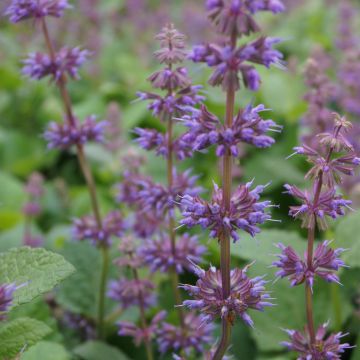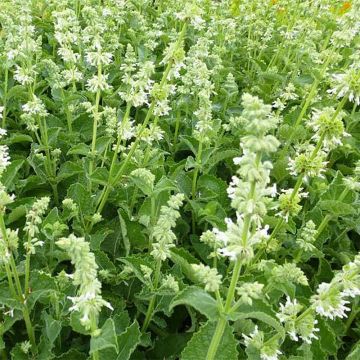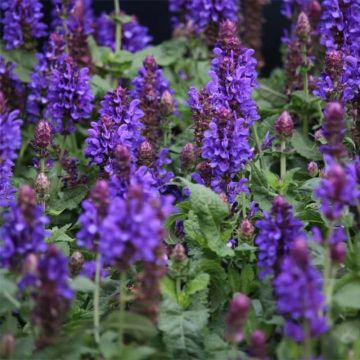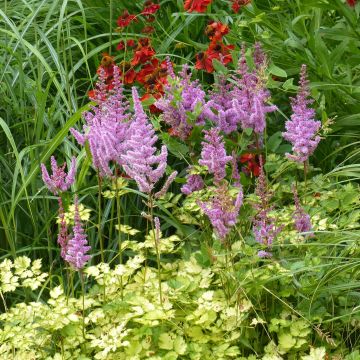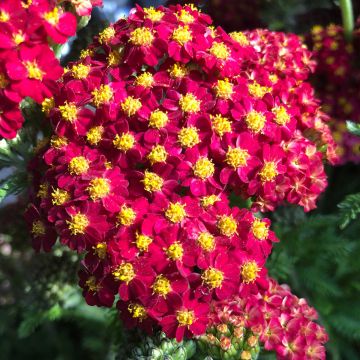

Salvia nemorosa Lubecca - Sauge des bois
Salvia nemorosa Lubecca
Woodland Sage, Balkan Clary
Seems to be thriving despite the heat of early September.
DiMar78, 10/09/2023
This item cannot be shipped to the selected country
Delivery charge from €5.90
Delivery to Corse prohibited
More information
Schedule delivery date,
and select date in basket
This plant carries a 12 months recovery warranty
More information
We guarantee the quality of our plants for a full growing cycle, and will replace at our expense any plant that fails to recover under normal climatic and planting conditions.
From €5.90 for pickup delivery and €6.90 for home delivery
Express home delivery from €8.90.
Delivery to Corse prohibited: UE law prohibits the import of this plant from mainland France to Corse as part of the fight against Xylella fastidiosa. Please accept our sincere apologies.
More information

Does this plant fit my garden?
Set up your Plantfit profile →
Description
The Salvia nemorosa 'Lubecca', also known as Wood Sage or Forest Sage, is a perennial plant that is erect and well-branched, offering an abundance of spike-like inflorescences in a blue-mauve colour, almost electric, intense and bright, from early to late summer. Compact and bushy, this sage is also distinguished by its lanceolate, slightly grey foliage, which is aromatic when crushed. Easy to grow, it is one of the hardiest sages.
Wood Sage (Salvia nemorosa) is a plant species in the Lamiaceae family. This perennial herbaceous plant is native to central Europe and western Asia. 'Lubecca' is one of its many cultivars, a sport derived from the selection 'East Friesland'. Its adult size will not exceed 50 cm (20in) in all directions. This perennial develops from a prostrate rosette of oval, rough leaves with dentate edges, measuring 10 cm (4in) long. It has a bushy, highly branched and compact habit. The flowering, particularly spread out, takes place from June to September, in terminal clusters composed of numerous small flowers (0.5 to 1 cm (0in)) in delphinium blue with purple bracts. This mixture of colours produces a strong and bright blue-violet effect. The beautiful nectar-rich flower spikes succeed each other throughout the summer and delight butterflies. The leaves, 5 to 10 cm (2 to 4in) long, are ovate or lanceolate, oblong, dentate, puckered, and greyish green. The base of the stems is often reddish.
'Lubecca' has the advantage of remaining compact, even in soil that is slightly too rich. It knows how to hold its shape! It will look superb alongside pale yellow flowering plants such as Anthemis 'Wargrave' for a strong contrast, or with grey foliage of artemisias and pink flowering plants. It is also perfect for creating massifs and borders alongside Perovskia, Artemisia, or perennial Geraniums.
With more than 900 species of annuals, perennials, and softwood shrubs distributed all over the world, except in very cold regions and tropical forests, the genus Salvia is the richest in the Lamiaceae family. The name Salvia, which dates back to Roman times, derives from the Latin salvus 'healthy' in reference to the medicinal properties of common sage.
Report an error about the product description
Salvia nemorosa Lubecca - Sauge des bois in pictures




Flowering
Foliage
Plant habit
Botanical data
Salvia
nemorosa
Lubecca
Lamiaceae
Woodland Sage, Balkan Clary
Cultivar or hybrid
Other Salvia - Sage
Planting and care
Salvia nemorosa 'Lubeca' should be planted from October to March, excluding the freezing period, with a spacing of 40cm (16in) in a well-drained soil, sheltered from cold winds and in full sun. In winter, add a light compost of manure or other organic matter. Prune it back to 30cm (12in) from the ground after flowering. Beware of gastropods that may attack young shoots. In humid areas, use a mineral mulch (gravel, pumice, pebbles) with a thickness of 4 to 6cm (2in) to help drain the neck of the plant. Under these conditions, it can withstand temperatures as low as -30°C (-22°F). Plant 'Lubeca' sage in ordinary, even poor and preferably chalky, but above all well-drained soil. This plant tolerates some drought. It does not appreciate heavy and waterlogged soils in winter, which can harm its hardiness. You should plant it in a sunny or semi-shaded location. It is an easy plant, very floriferous. Fertilize in spring and in April, prune all the branches by half. After flowering, cut back the faded flower stems to stimulate and prolong flowering. To preserve the vitality of the sage, it is good to divide the plant after 3 years. Plant the new plants in well-worked soil: to improve slightly poor soil, mix in some horticultural compost.
Planting period
Intended location
Care
-
, onOrder confirmed
Reply from on Promesse de fleurs
Summer flowering perennials
Haven't found what you were looking for?
Hardiness is the lowest winter temperature a plant can endure without suffering serious damage or even dying. However, hardiness is affected by location (a sheltered area, such as a patio), protection (winter cover) and soil type (hardiness is improved by well-drained soil).

Photo Sharing Terms & Conditions
In order to encourage gardeners to interact and share their experiences, Promesse de fleurs offers various media enabling content to be uploaded onto its Site - in particular via the ‘Photo sharing’ module.
The User agrees to refrain from:
- Posting any content that is illegal, prejudicial, insulting, racist, inciteful to hatred, revisionist, contrary to public decency, that infringes on privacy or on the privacy rights of third parties, in particular the publicity rights of persons and goods, intellectual property rights, or the right to privacy.
- Submitting content on behalf of a third party;
- Impersonate the identity of a third party and/or publish any personal information about a third party;
In general, the User undertakes to refrain from any unethical behaviour.
All Content (in particular text, comments, files, images, photos, videos, creative works, etc.), which may be subject to property or intellectual property rights, image or other private rights, shall remain the property of the User, subject to the limited rights granted by the terms of the licence granted by Promesse de fleurs as stated below. Users are at liberty to publish or not to publish such Content on the Site, notably via the ‘Photo Sharing’ facility, and accept that this Content shall be made public and freely accessible, notably on the Internet.
Users further acknowledge, undertake to have ,and guarantee that they hold all necessary rights and permissions to publish such material on the Site, in particular with regard to the legislation in force pertaining to any privacy, property, intellectual property, image, or contractual rights, or rights of any other nature. By publishing such Content on the Site, Users acknowledge accepting full liability as publishers of the Content within the meaning of the law, and grant Promesse de fleurs, free of charge, an inclusive, worldwide licence for the said Content for the entire duration of its publication, including all reproduction, representation, up/downloading, displaying, performing, transmission, and storage rights.
Users also grant permission for their name to be linked to the Content and accept that this link may not always be made available.
By engaging in posting material, Users consent to their Content becoming automatically accessible on the Internet, in particular on other sites and/or blogs and/or web pages of the Promesse de fleurs site, including in particular social pages and the Promesse de fleurs catalogue.
Users may secure the removal of entrusted content free of charge by issuing a simple request via our contact form.
The flowering period indicated on our website applies to countries and regions located in USDA zone 8 (France, the United Kingdom, Ireland, the Netherlands, etc.)
It will vary according to where you live:
- In zones 9 to 10 (Italy, Spain, Greece, etc.), flowering will occur about 2 to 4 weeks earlier.
- In zones 6 to 7 (Germany, Poland, Slovenia, and lower mountainous regions), flowering will be delayed by 2 to 3 weeks.
- In zone 5 (Central Europe, Scandinavia), blooming will be delayed by 3 to 5 weeks.
In temperate climates, pruning of spring-flowering shrubs (forsythia, spireas, etc.) should be done just after flowering.
Pruning of summer-flowering shrubs (Indian Lilac, Perovskia, etc.) can be done in winter or spring.
In cold regions as well as with frost-sensitive plants, avoid pruning too early when severe frosts may still occur.
The planting period indicated on our website applies to countries and regions located in USDA zone 8 (France, United Kingdom, Ireland, Netherlands).
It will vary according to where you live:
- In Mediterranean zones (Marseille, Madrid, Milan, etc.), autumn and winter are the best planting periods.
- In continental zones (Strasbourg, Munich, Vienna, etc.), delay planting by 2 to 3 weeks in spring and bring it forward by 2 to 4 weeks in autumn.
- In mountainous regions (the Alps, Pyrenees, Carpathians, etc.), it is best to plant in late spring (May-June) or late summer (August-September).
The harvesting period indicated on our website applies to countries and regions in USDA zone 8 (France, England, Ireland, the Netherlands).
In colder areas (Scandinavia, Poland, Austria...) fruit and vegetable harvests are likely to be delayed by 3-4 weeks.
In warmer areas (Italy, Spain, Greece, etc.), harvesting will probably take place earlier, depending on weather conditions.
The sowing periods indicated on our website apply to countries and regions within USDA Zone 8 (France, UK, Ireland, Netherlands).
In colder areas (Scandinavia, Poland, Austria...), delay any outdoor sowing by 3-4 weeks, or sow under glass.
In warmer climes (Italy, Spain, Greece, etc.), bring outdoor sowing forward by a few weeks.

































